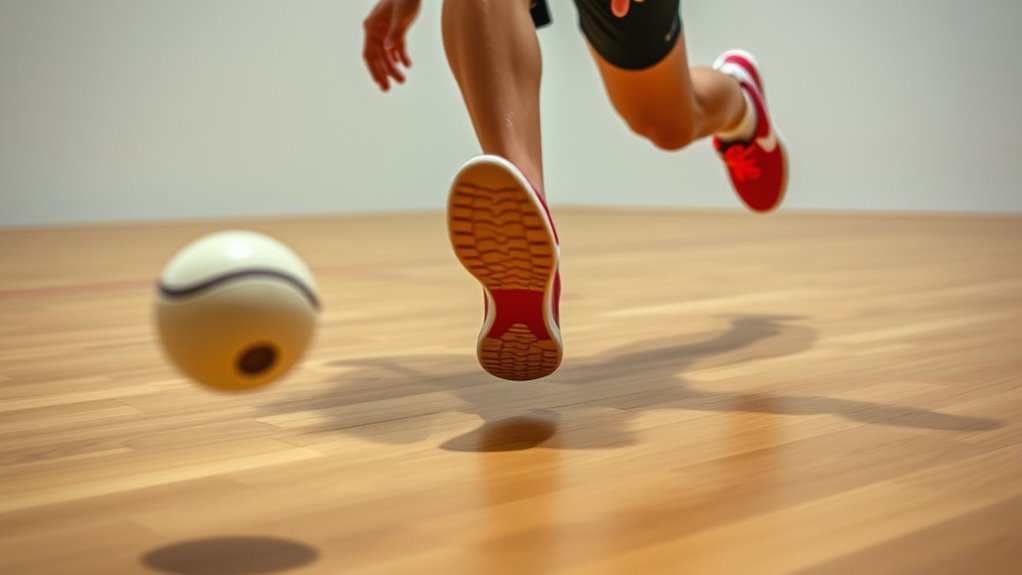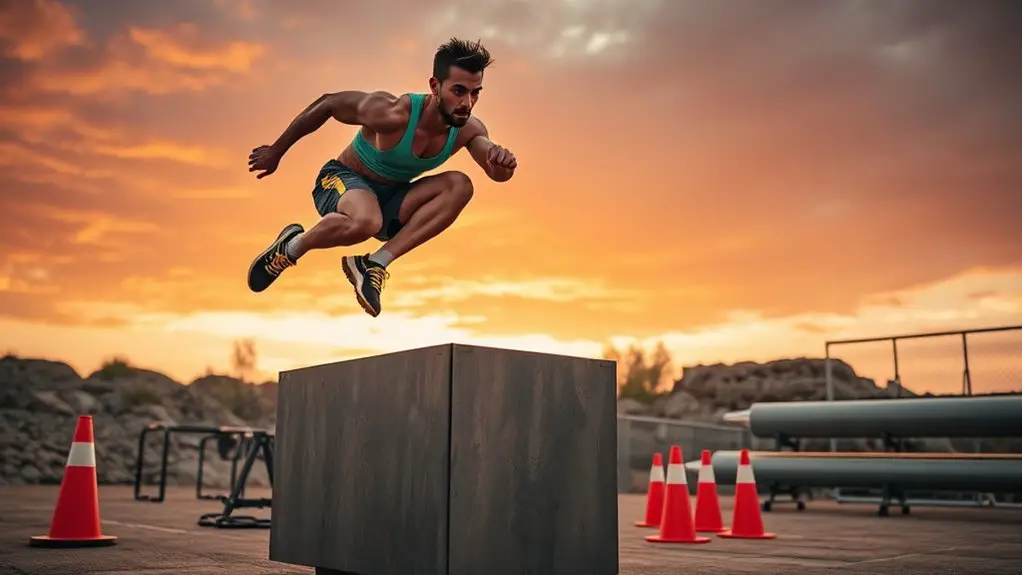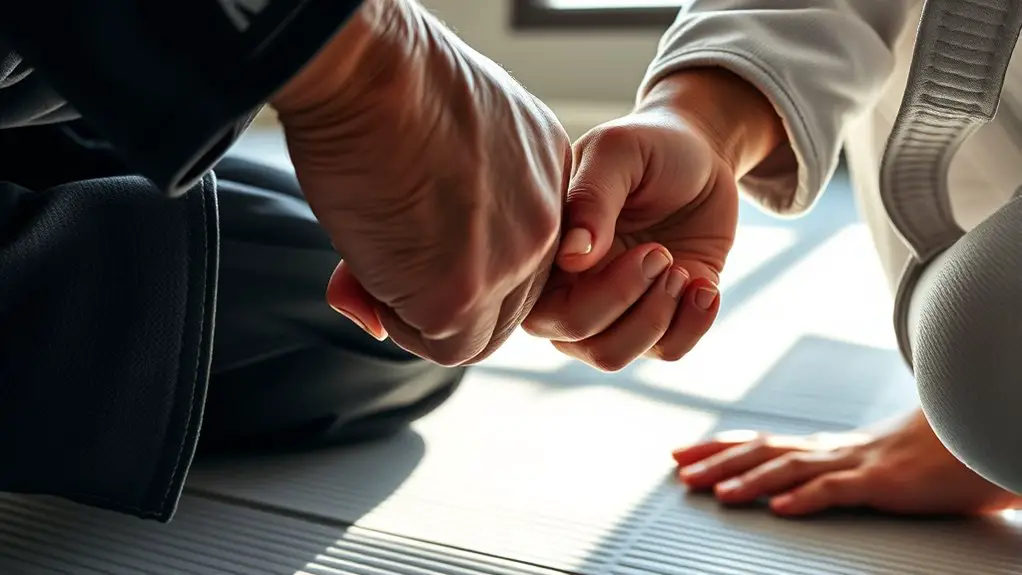Footwork plays an essential role in your squash performance, affecting your speed, agility, and shot accuracy. Mastering foot placement gives you stability, while maintaining balance enhances your shot precision. Incorporating techniques like the split step and lateral movement helps you react quickly to your opponent. Plus, agile footwork supports swift direction changes, keeping you in an ideal position for every shot. Keep exploring how to refine your footwork to elevate your game further.
Understanding the Basics of Footwork
When you're on the squash court, mastering footwork is essential for improving your game. It all starts with foot placement; the way your feet connect with the floor can make or break your efficiency in movement. You want to position your feet correctly to react quickly and reach the ball with ease.
Think of your movement as a dance—fluid and dynamic. By practicing proper foot placement, you'll enhance your movement efficiency, allowing you to glide across the court rather than lumber. Position yourself with your feet shoulder-width apart, ready to pivot or sprint. Additionally, integrating agility training techniques into your practice can significantly boost your responsiveness on the court.
The Importance of Balance in Movement
Balance is essential for your performance in squash, as it directly affects your stability during shots. When you're well-balanced, you can make quick direction changes without losing your footing. This not only improves your accuracy but also helps you respond effectively to your opponent's movements. Additionally, good balance reduces injury risk, allowing you to participate in matches more safely and effectively.
Stability During Shots
Stability is essential for executing successful shots in squash. When you're balanced, you'll notice how your shot accuracy improves dramatically. Proper foot placement allows you to strike the ball with confidence, leading to powerful and precise shots that can outsmart your opponent.
Imagine yourself:
- Standing firm, feet shoulder-width apart
- Shifting your weight smoothly as you prepare
- Planting your foot just right for a perfect swing
- Following through with ease, feeling grounded
Quick Direction Changes
Executing shots with precision isn't just about stability; it's also about your ability to quickly change direction on the court. Mastering quick direction changes hinges on effective pivot techniques and lateral movement. When you sense your opponent's next move, being able to pivot swiftly keeps you agile, allowing you to respond without losing your balance.
Incorporate lateral movement into your footwork drills—this'll enhance your ability to dart across the court with ease. The better you can shift your weight and adjust your stance, the more freedom you'll feel in your game. Remember, these quick changes aren't just tactical; they're essential for maintaining control and setting up your next shot. Embrace the flow, and let your feet guide you!
Common Footwork Techniques in Squash
While mastering footwork techniques in squash is essential for enhancing your overall performance, several key methods can help elevate your game. Focusing on these common techniques can greatly improve your agility and responsiveness on the court:
Mastering footwork techniques is crucial for improving performance and agility in squash, enhancing your responsiveness on the court.
- Split step: This quick, explosive move sets you up for your next shot, enhancing your foot speed and readiness.
- Lateral movement: Engage in drills that promote side-to-side agility, increasing your directional awareness and efficiency.
- Shuffle technique: Use this to cover short distances quickly, perfect for adjusting your foot positioning.
- Recovery strides: Focus on backpedal drills to enhance your stride length and return to the center after each play. Incorporating footwork drills into your training can further refine your movement efficiency and effectiveness on the court.
Developing Agility for Better Footwork
To improve your footwork in squash, developing agility is essential, as it allows you to move swiftly and effectively around the court. Incorporate various agility drills into your training routine to enhance your footwork patterns. Focus on speed training and lateral movement to make quick adjustments during play. Proper footwork not only improves performance but also reduces the risk of injuries through effective placement.
Here's a simple table to guide your agility workouts:
| Exercise Type | Focus Area | Benefits |
|---|---|---|
| Agility Drills | Coordination Skills | Quick foot positioning |
| Reaction Exercises | Speed & Agility | Improved response time |
| Plyometric Workouts | Power & Endurance | Explosive movements |
| Flexibility Exercises | Range of Motion | Injury prevention |
| Endurance Training | Overall Stamina | Sustained performance |
The Role of Positioning in Shot Execution
Positioning plays an essential role in shot execution, as it directly influences your ability to hit the ball with precision and power. When you're aware of your surroundings and anticipate where the ball is going, you can optimize your shot placement. Here are some key elements to reflect upon:
- Balance: Keep your weight centered to maintain control over your shots.
- Distance: Position yourself at the right distance from the ball for a cleaner hit.
- Angle: Adjust your body angle to enhance the trajectory of your shot.
- Follow-through: Confirm your follow-through aligns with your intended shot placement for added accuracy.
Being mindful of your court awareness allows you to react swiftly and execute effective shots. Embrace the freedom of movement and let your positioning guide you in making decisive plays. Mastering this aspect can elevate your game and keep your opponents guessing.
How Footwork Affects Speed and Reaction Time
Your footwork directly impacts your speed and reaction time on the court. By mastering quick movement techniques and positioning yourself correctly, you can set up for ideal shots. Plus, improving your anticipation skills will give you the edge to respond faster to your opponent's moves. Incorporating agility ladder drills into your training routine can significantly enhance your foot speed and coordination.
Quick Movement Techniques
Mastering quick movement techniques is essential for squash players looking to enhance their speed and reaction time on the court. By focusing on effective footwork, you can develop explosive starts and agile lateral movement, giving you the freedom to navigate the game effortlessly. Here are some techniques to take into account:
- Short, quick steps to pivot and change direction rapidly
- Powerful lunges for reaching those elusive shots
- Fast recovery to return to a balanced position after each play
- Body positioning that promotes fluid movement and minimizes effort
Incorporating these techniques into your training can transform your game, allowing you to respond instantly and move freely, making every rally an opportunity to shine.
Positioning for Optimal Shots
Effective footwork not only sets the stage for quick movement but also plays an essential role in positioning for ideal shots during a match. When you master your footwork, you can enhance your shot selection, making it easier to hit the ball accurately and powerfully. By staying light on your feet and adjusting your position quickly, you'll find yourself in the perfect spot to execute your planned shots. Court awareness is significant here; knowing where to be allows you to anticipate your opponent's moves and position yourself accordingly. This combination of agile footwork and strategic positioning gives you the freedom to play your game, ensuring that your shots are as effective as possible while keeping you one step ahead on the court.
Anticipation and Reaction Skills
While quick footwork is essential in squash, it's your ability to anticipate your opponent's next move that truly enhances your speed and reaction time. By honing your anticipation techniques, you can gain that edge in gameplay. Consider these aspects:
- Watching your opponent's body language for cues
- Reading the ball's trajectory before it reaches you
- Practicing reaction drills to improve your reflexes
- Staying light on your feet to pivot quickly
When you combine sharp footwork with effective anticipation, you become a more agile player, ready to seize opportunities. Embrace the freedom of movement and flow, and watch how your enhanced speed and reaction time elevate your performance on the court. It's all about being one step ahead!
Drills to Improve Your Footwork
Improving your footwork in squash is essential for enhancing your overall performance on the court. You can incorporate various drills to boost your agility and control. Here are some effective exercises:
| Drill Type | Description | Benefits |
|---|---|---|
| Ladder Drills | Use an agility ladder to practice quick foot movements and coordination. | Increases speed and agility. |
| Shadow Movements | Mimic game movements without a ball to enhance foot positioning. | Improves anticipation and balance. |
| Side Shuffles | Shuffle sideways across the court to develop lateral movement. | Strengthens side-to-side agility. |
| Split Step | Practice the split step as you prepare for shots to enhance your reaction time. | Prepares you for quick movements. |
Incorporate these drills into your routine, and you'll notice a significant improvement in your footwork, allowing you to play more freely and effectively on the court.
Analyzing Footwork in Professional Matches
After practicing drills to enhance your footwork, it's time to see how those skills play out in real matches. Match analysis of professional players reveals the importance of fluid player movement, allowing them to dominate the court. Here's what to look for:
Analyzing professional players highlights the crucial role of fluid footwork in mastering the game.
- Quick, precise steps to reach the ball effortlessly
- Smooth shifts between offensive and defensive positions
- Anticipation of the opponent's shots, leading to better positioning
- An effortless balance that keeps them ready for any direction
When you watch these athletes, notice how their footwork creates opportunities and minimizes errors. Every step is intentional, showcasing the freedom of movement that comes from mastering footwork. By studying their techniques, you can inspire your own game and elevate your performance on the court. Additionally, incorporating reaction time improvement strategies can further enhance your ability to respond quickly during matches.
Preventing Injuries Through Proper Footwork
Proper footwork is essential not only for enhancing performance but also for preventing injuries on the squash court. When you move fluidly and with purpose, you're less likely to strain muscles or twist your joints in awkward ways. Focus on maintaining a low center of gravity and using quick, controlled steps. This keeps your body stable and balanced, reducing the risk of falls or missteps that lead to injury.
Incorporating proper footwork into your game isn't just about playing better; it's a significant part of injury prevention. Make sure you warm up properly before hitting the court, as this prepares your muscles for the demands of the game. Additionally, regular dynamic stretching before play can significantly reduce the risk of hamstring injuries. If you do get injured, effective recovery is essential. Rest, ice, and gentle stretching can help you bounce back quicker, allowing you to get back to playing the sport you love without lingering pain or discomfort.
Integrating Footwork Into Your Training Regimen
While many players focus on tactics and strategy, integrating footwork into your training regimen is equally essential for success on the squash court. To elevate your game, consider incorporating various footwork variations that challenge your agility and enhance your movement. Here are some ideas to spice up your training:
- Lateral shuffles to improve quick side-to-side movement
- Forward and backward sprints for explosive responses
- Diagonal lunges to strengthen your reach and balance
- Shadowing drills that mimic game scenarios to build muscle memory. Additionally, integrating plyometric exercises into your routine can significantly boost your speed and agility on the court.
Frequently Asked Questions
How Does Footwork Impact Overall Squash Strategy?
Footwork dynamics play an essential role in your overall squash strategy. When you master your footwork, you're able to position yourself strategically on the court, allowing for quick reactions and ideal shot placement. You'll find that being light on your feet helps you anticipate your opponent's moves, giving you the freedom to control the game. So, focus on improving your footwork, and watch how it elevates your squash performance!
Can Footwork Techniques Vary by Playing Style?
Imagine gliding effortlessly across the court, each step a dance with strategy. Your footwork techniques can indeed vary by playing style. Aggressive players might prioritize movement efficiency and quick recovery speed to dominate the game, while defensive players focus on precise court positioning and shot selection. Whether you're lunging forward or retreating gracefully, adapting your footwork to your style gives you the freedom to express your unique game, enhancing your overall performance.
What Common Mistakes Do Players Make With Footwork?
When it comes to footwork, players often make common mistakes that can really hold you back. Poor balance is a big issue; if you're not stable, you can't move effectively. Inefficient movement also creeps in when players don't engage their legs properly or overreach. It's crucial to stay light on your feet and be mindful of your positioning to avoid these pitfalls. Embrace fluidity in your movement to elevate your game!
How Often Should I Practice Footwork Drills?
Practicing footwork drills is as essential as breathing to a squash player. Aim for at least two to three sessions a week, integrating them into your training schedules. This frequency helps develop your agility and coordination, making your movements more fluid. Remember, it's not just about quantity; quality matters too! So, don't hesitate to mix things up and keep it enjoyable. You'll be amazed at how quickly your skills can improve!
Are There Specific Shoes Recommended for Better Footwork?
When you're looking for shoes for better footwork, focus on shoe features like grip, cushioning, and stability. Brands like Asics, Adidas, and Nike offer models designed specifically for court sports. These shoes can enhance your agility and comfort, allowing you to move freely on the court. Don't underestimate the impact of good footwear; it can make a significant difference in your performance and overall enjoyment of the game.




